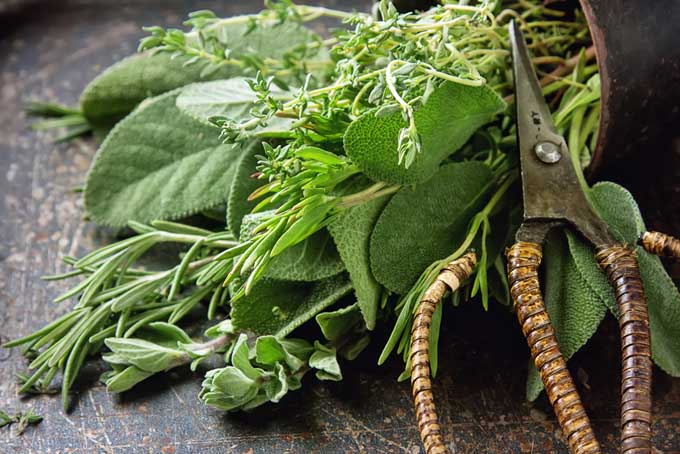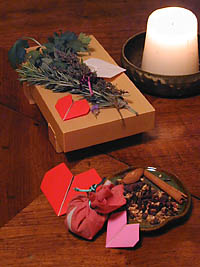Are you going to Scarborough Fair? Parsley, sage, rosemary, and thyme, Remember me to one who lives there, She once was a true love of mine. So begins the old Simon and Garfunkel song “Scarborough Fair,” borrowed from the Elizabethans, and a fine lot they were. What seems on the surface to be a perfectly innocent folk song turns out to be riddle of devilish complexity. Nevertheless, we as herbalists are in a prime position to figure it out. Let’s reconstruct: First, the hero of the song gets a third party to take a lengthy message to his ex-lover who lives in another town. In this message, he instructs her to perform 5 impossible tasks as prerequisites to getting him back – everything from sewing a shirt with no seams to finding him some land between the sand and the sea. So much for the idea that this is a straightforward love song. Have her make me a cambric shirt, indeed. Does he love her, or is he kissing her off? Pondering this question, the modern herbalist noticed that in between all this dictatorial preaching was the refrain, “parsley, sage, rosemary, and thyme.” Aha! Perhaps there is the clue to his meaning. Here’s how the song ends: If she tells me she can’t, I’ll reply, Parsley, sage, rosemary, and thyme, Let me know that at least she will try, And then she’ll be a true love of mine. Love imposes impossible tasks, Parsley, sage, rosemary, and thyme, Though not more than any heart asks, And I must know she’s a true love of mine. Dear, when thou hast finished thy task, Parsley, sage, rosemary, and thyme, Come to me, my hand for to ask, For then thou art a true love of mine. In short, it seems like all she has to do if she wants him back is perform a few garden-variety, herculean tasks of the sort usually doled out by Zeus or unusually mean witches. Begging the question of why she’s in Scarborough Fair to begin with if she likes him even a little bit. Looking deep into the magical lore currently available online, the modern herbalist discovered much about parsley, sage, rosemary, and thyme that she did not previously know. For instance,
Thyme: Girls once used thyme sprigs in ceremonies to discover the identity of their true loves. A more upscale lady of Medieval times would embroider a flowering thyme sprig along with a visiting bee as a token to be given to a favored knight. A woman wearing thyme was once thought to be irresistible. Read about growing thyme now. Sage: Sage was once used to help childless couples conceive, and is associated with wisdom and longevity in plant lore. It was also used magically to honor weddings and to ensure domestic harmony. Learn to grow sage. Rosemary: Was once held to represent love and faithfulness. The plant was used in wedding ceremonies in place of rings as a sign of fidelity, and carried by newlyweds and wedding guests as a charm for fertility. But it also has the meaning of remembrance, as Shakespeare noted in Hamlet, “There’s rosemary for remembrance.” Often used in love potions, it is also said to attract elves. Rosemary is easy to grow. Find out how now. Parsley: It was once said that only witches and pregnant women could grow this herb. “Sow parsley, sow babes,” was an old expression. The herb has been associated with witchcraft in England and also with death since ancient times. But more importantly, it is said to provoke lust and love. Learn to grow yours today.
So, given this new information, one might perhaps construct a scenario such as the following: Our hero has been dumped by her beau. She is no longer interested in him, and has in fact left him for another. And she’s going to the fair. Our hero is in denial of these basic facts, and when he hears that his best friend is coincidentally going to Scarborough Fair, he gives him a message to pass on to her. He tells her that her chances of getting him back are nil unless she can prove her love for him by doing impossible tasks. Of course she can’t prove her love, not on these terms, but this fact is lost on our hero.
Or maybe not. He also passes along a little metaphorical token of his feelings in the form of the bouquet: parsley, sage, rosemary, and thyme. Keeping in mind the available lore, here is one possible translation:
Thyme: I’m yours. Sage: I’m dependable. Rosemary: Remember me. Parsley: I want to make babies with you.
Okay, we get it now. This is no ordinary posey; this is love magic. Here’s where he’s at: he knows she’s in love with someone else, and there’s no way of getting her back. But he’s still in love with her, and he’s also bitter that she left him. Does he want her back? You bet. Does he think he has a snowball’s chance in hell of doing so? No way. So he decides to send her a double-edged message. On the one hand, it’s a kiss-off: Prove your love and then maybe I’ll marry you. Oops, you can’t prove your love. This saves him in the event that she really doesn’t want anything to do with him. On the other hand, it’s also leaving the door open: Let me know that at least she will try, and then she’ll be a true love of mine. There, he’s letting her off easy. Which brings us to the third party. Who is this middleman, anyway? Can he be trusted? How do we know that it isn’t the messenger who is concealing or tampering with her affections? And of course we have no way of knowing how our heroine in absentia is going to take this strange message. Given the times, she probably has a good laugh, in bed with her lover like a character out of a French epistolary novel. But anything is possible. The herbs do not speak of her. Or more accurately, the herbs are her, or at least a reflection of who our hero wants her to be. Will he get her back? I guess it depends on whether or not he picked the right herbs – or the right woman. Not all love stories need be this twisted. In honor of the season, we present a small collection of love philtres and potions for your non-profit, fully disclaimed use on the love object of your choice:
You Will Need
Parsley Sage Rosemary Thyme Assorted additional herbs and doodads A sense of humor
The Vervained Kiss
Take a piece of the plant vervain into your mouth and kiss the one you desire, while saying these words: “Pax tibi sum sensum conterit in amore me.” I leave it to you to decipher the Latin, as well as exactly when one should recite the verse while kissing your unsuspecting beloved.
A Charm To Draw Love
Use a circle of cloth in a love color, such as pink or red. Fill it with scented, romantic herbs and flowers such as rose buds, jasmine, lavender, lemon verbena, and even some of the spicy herbs such as cinnamon and anise. Add a red felt heart and a copper coin, and tie the bag together with a piece of blue floss or thread, using seven knots. Carry this charm with you to draw love your way. (This one is courtesy of Starhawk.) Take a nice bath, with candles and bath salts. Light incense. Revel in your wet nakedness for a while (but not too much – you still have a ritual to perform). Put on a sexy, goddess-evoking robe and have a seat somewhere comfortable. Make sure your tea is at hand, along with spoon and honey, as well as any snack items that might need to be consumed. Finally, light a candle of the color that represents your desired lover. Is he hot? Make it red. Is he cool? Make it blue. You’ll know the right color to use. And finally, visualize. This will be difficult for some of you, no doubt, but try… Okay, you’ve done the magic part. Now drink your tea (or magic formula in this case) and eat your snack. Thank the powers that be. Happy St. Valentine’s Day, everyone! And don’t forget: we have plenty of growing guides available to help you to learn to grow your own at home! © Ask the Experts, LLC. ALL RIGHTS RESERVED. See our TOS for more details. Uncredited photos: Shutterstock.



